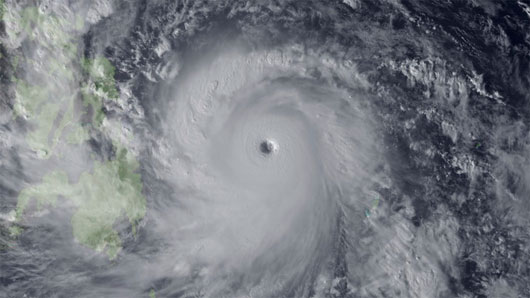Why is Typhoon Haiyan so strong?
Typhoon Haiyan is entering the South China Sea as the strongest storm in many years, threatening to cause great damage. This is also the strongest storm on our planet this year.
Tyan Maue, a meteorologist at the Weatherbell Analytics Meteorological Consulting Company, wrote on Twitter that Haiyan has the strongest winds since the Super Typhoon Tip appeared in 1979, causing heavy losses in Guam and Japan.

Haiyan superhuman mind - Photo: Reuters
LiveScience quoted tropical weather expert Brian McNoldy of the University of Miami in the US as saying Hai Yen was too strong because it met all the conditions.
Firstly , according to McNoldy, it forms on the open ocean, there is no large mainland to prevent it from forming a symmetrical spiral, which helps a whirlwind wind form and add steam.
Secondly , the ocean temperature is surprisingly warm, above 30 degrees C. More importantly, warm water spreads deep into the ocean, which means that the upwelling phenomenon caused by the wind does not stir up. Cold water, which can help weaken the swirling wind power. Tropical storms are basically giant thermal machines, powered by relaying heat from the ocean to the upper atmosphere.
Third , there was little wind shear at this time, according to McNoldy. Wind shear helps break down a storm that is forming and prevents the storm from intensifying.
- Typhoon Haiyan is heading into Quang Ngai
- In the next 24 hours, the mind of the super typhoon Haiyan enters the waters of Hue-Binh Dinh
- The world's strongest storm hit the Philippines
- Haiyan storm left Vietnam, at least 13 people died
- 10,000 people may have died due to Typhoon Haiyan in the Philippines
- The North urgently resisted Typhoon Haiyan
- Super Typhoon Haiyan enters the South China Sea
- Haiyan storm turned to Thanh Hoa
- Super typhoon Haiyan is about to land in Philippines
- Typhoon Haiyan weakens gradually and goes to China
- The UN confirmed 4,460 people in the Philippines died of Typhoon Haiyan
- Latest data on typhoon Haiyan consequences in the Philippines
 Is the magnetic North Pole shift dangerous to humanity?
Is the magnetic North Pole shift dangerous to humanity? Washington legalizes the recycling of human bodies into fertilizer
Washington legalizes the recycling of human bodies into fertilizer Lightning stone - the mysterious guest
Lightning stone - the mysterious guest Stunned by the mysterious sunset, strange appearance
Stunned by the mysterious sunset, strange appearance What is the fastest wind speed ever recorded?
What is the fastest wind speed ever recorded?  Hybrid energy raft provides electricity to 1,000 homes per day
Hybrid energy raft provides electricity to 1,000 homes per day  'Small but mighty' turbine generates energy from gentle winds
'Small but mighty' turbine generates energy from gentle winds  What material is the world's largest wind turbine blade made of that is 9 times stronger than steel?
What material is the world's largest wind turbine blade made of that is 9 times stronger than steel?  The strongest wind tunnels in the world
The strongest wind tunnels in the world  The Netherlands built the world's largest floating offshore solar farm
The Netherlands built the world's largest floating offshore solar farm 